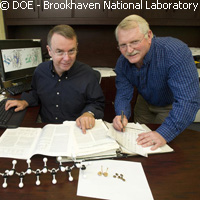Study reveals secret behind plant biochemistry and enzyme control
Researchers in Sweden and the United States have identified how an enzyme 'knows' where to insert a double bond when desaturating plant fatty acids. Presented in the journal Proceedings of the National Academy of Sciences (PNAS), the study pieces together the 40-year-long puzzle of how enzymes exert such location-specific control. This information can fuel our understanding of this mechanism that depends on a single amino acid located away from the enzyme's active site. Scientists can take advantage of this data to use plant oils as a renewable replacement for petrochemicals. 'Plant fatty acids are an approximately USD 150 billion (EUR 110 billion) a year market,' explains lead author John Shanklin of the Brookhaven National Laboratory at the US Department of Energy (DOE) in the United States. 'Their properties, and therefore their potential uses and values, are determined by the position of double bonds in the hydrocarbon chains that make up their backbones. Thus the ability to control double bond positions would enable us to make new designer fatty acids that would be useful as industrial raw materials.' Desaturases, what experts define as enzymes responsible for double-bond placement, remove hydrogen atoms and insert double bonds between adjacent carbon atoms at specific locations on the hydrocarbon chains. The big question, however, is how an enzyme knows to insert the double bond at one location while a varied yet closely related enzyme inserts a double bond at another. Enter the team from Brookhaven that worked together with scientists from Karolinska Institutet in Sweden to get the answer. 'Most enzymes recognise features in the molecules they act on that are very close to the site where the enzyme's action takes place,' Dr Shanklin says. 'But all the carbon-hydrogen groups that make up fatty-acid backbones are very similar with no distinguishing features - it's like a greasy rope with nothing to hold onto.' The researchers investigated two desaturases that were genetically similar but at different locations: a castor desaturase and an ivy desaturase. According to them, it would not be hard to identify any differences in such examples. However, initial efforts to find an explanation clarifying this were not very fruitful. 'The crystal structures are almost identical,' Dr Shanklin says. So the team then decided to examine how the two enzymes bind to their substrates (fatty acid chains attached to a small carrier protein). At first, they assessed the crystal structure of the castor desaturase bound to the substrate. Afterwards they used computer modelling to evaluate how the carrier protein 'docked' with the enzyme. 'Results of the computational docking model exactly matched that of the real crystal structure, which allows carbon atoms 9 and 10 to be positioned right at the enzyme's active site,' the Brookhaven researcher says. They then modelled the docking of the carrier protein with the ivy desaturase. Here, it docked in a different orientation that placed carbon atoms at the desaturation active site. 'So the docking model predicted a different orientation that exactly accounted for the specificity,' he points out. 'It's very rewarding to have finally solved this mystery, which would not have been possible without a team effort drawing on our diverse expertise in biochemistry, genetics, computational modelling, and X-ray crystallography,' Dr Shankin says. 'Using what we've now learned, I am optimistic we can redesign enzymes to achieve new desirable specificities to produce novel fatty acids in plants. These novel fatty acids would be a renewable resource to replace raw materials now derived from petroleum for making industrial products like plastics.'For more information, please visit:PNAS:http://www.pnas.org/DOE/Brookhaven National Laboratory:http://www.bnl.gov/world/Karolinska Institutet:http://ki.se/ki/jsp/polopoly.jsp;jsessionid=a_uHGIlPWe78v42Vjk?l=en&d=130
Countries
Sweden, United States



